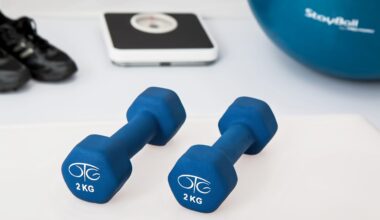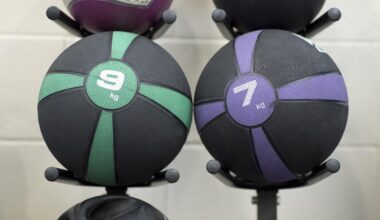Speed Development Techniques for Basketball Athletes
Developing speed is crucial for basketball players. Whether you are in defense or offense, speed can be the difference between winning and losing. Athletes need to focus on various conditioning methods to enhance their speed. One effective way to improve speed is through sprint drills. These drills not only build muscle power but also improve technique and overall athleticism. Additionally, agility training is vital in basketball; it allows players to maneuver quickly on the court. Incorporate ladder drills and cone drills in your routine to develop agility. Plyometric exercises are beneficial as well. They help increase explosive power which translates directly to improved speed during gameplay. Weight training can also add value by strengthening muscles, allowing them to move faster. Ensure workouts focus not just on maximum load, but also on speed-focused reps. Proper nutrition plays a role in recovery, energy levels, and performance. Lastly, train regularly. Consistency is key for speed development. By following a structured training routine, athletes can optimize their speed and reaction time, leading to enhanced overall performance on the basketball court.
Agility and Speed Drills
Incorporating agility drills in your training routine is essential for basketball players wanting to improve their speed. Agility drills, such as the shuttle run or zig-zag cone drills, can significantly enhance your footwork and acceleration. During these drills, focus on quick changes in direction which mimics the movements made on the court. Another excellent method is resistance sprinting; using parachutes or sleds can help in developing strength and speed simultaneously. The use of these tools adds an element of resistance to your sprints. Additionally, hill sprints should be included in your training regimen. Sprinting uphill develops leg power and improves speed on flat surfaces. Remember that proper form is crucial for all drills. You wouldn’t want to develop bad habits in your technique. When performing drills, opt for correct postures and efficient movements. Lastly, incorporate rest intervals for optimal performance. Short bursts of intense training followed by short recovery periods lead to excellent outcomes in speed development. In summary, sectoring specific time for agility and resistance training will help aspiring basketball players reach their velocity goals.
Speed ladders are another great tool that can enhance your foot speed and coordination. This training gear allows for varied drills, increasing lateral movement and quickness essential for basketball. The training purpose of speed ladders is twofold: speed increase and footwork execution. Performing drills like the In-In-Out is highly effective; this exercise emphasizes quick feet and agility. Speed ladders teach muscle coordination and control, setting a foundation for faster plays during games. Remember to mix workouts; having a diversified training session ensures muscles are challenged differently, potentially leading to improvements in overall speed. Additionally, track your progress to ensure your training is effective. Recording improvements in speed can keep you motivated and make necessary adjustments to your regimen. Another useful method is the use of weighted vests during sprint workouts. This added weight challenges the muscles, promoting speed gains once the weight is removed. Ultimately, effective training requires a combination of strength, speed, agility, and endurance. Balancing these elements will help basketball players exhibit superior speed and elevate their competitive game, ensuring they perform to the best of their abilities during any matchup.
Plyometric Training for Speed Development
Plyometric training should not be overlooked in speed development programs tailored for basketball athletes. These explosive movements can significantly enhance the athlete’s ability to accelerate. Exercises such as box jumps and depth jumps train the body to respond quickly and explosively. By utilizing the stretch-shortening cycle of muscle contractions, athletes can build the necessary power for sprinting. Experiment with differing heights and obstacles to keep training challenging and stimulating. Additionally, incorporating split jumps or plyometric push-ups can help in developing strength and speed simultaneously. It is advisable to include appropriate warm-ups before engaging in these high-intensity activities to prevent injuries. Include dynamic stretches to prepare the muscles for the demands ahead. Recovery is equally important; provide sufficient rest days for your muscles to regenerate. Implement recovery techniques such as foam rolling, stretching, or yoga to promote flexibility. Furthermore, athletes should never overlook the importance of mental conditioning. Visualizing successful movements can lead to improved performance on the court. In summary, adopting plyometric training can lead to remarkable speed enhancements when incorporated correctly into overall training routines for basketball players.
Athletes should always listen to their bodies during speed development training. Pushing too hard without allowing proper recovery can lead to injuries that might hinder your training. Be mindful of signs of fatigue, as they can compromise your progress. Implementing a structured program around periods of rest can mitigate these issues. Cross-training is beneficial as well; engaging in activities like swimming or cycling eases the impact on the body while maintaining fitness. Maintain a balanced diet focused on protein, carbohydrates, and healthy fats to support muscle recovery and energy. Consider working with a coach or trainer specialized in speed training who can assess your form and suggest preventative measures. Techniques will vary according to individual needs. Lastly, demystify your long-term goals into manageable short-term objectives. Setting measurable goals will keep you focused and motivated as you progress. Celebrate these small victories to increase confidence. Ultimately, speed development requires dedication, discipline, and strategic planning to effectively enhance the athlete’s performance on the basketball court. By following these guidelines, players can not only improve speed but also overall gameplay efficiency.
Nutrition and Recovery
Nutrition and recovery are paramount for any athlete focusing on speed enhancement. A well-rounded diet provides essential nutrients that fuel workouts, and recovery processes that are often overlooked. Keeping hydrated is critical for performance. Dehydration can lead to fatigue, hindering speed training. Aim to drink ample water before, during, and after workouts. Additionally, consider post-workout nutrition; consuming protein and carbohydrates helps muscle recovery and replenishes energy. Foods rich in antioxidants can reduce inflammation, aiding recovery time after intense training. Whole grains, lean proteins, fruits, and vegetables should be staples in any basketball athlete’s diet. Supplements can be considered, but always consult a healthcare professional beforehand. Balancing calories consumed with calories burned is crucial in maintaining an optimal weight. Moreover, implementing a regular sleep schedule facilitates muscle repair and overall mental focus. Sleep deprivation negatively impacts performance and reaction times, essential elements for any basketball game. Lastly, consider periodic assessments to evaluate your training program and nutrition strategies. Refine your approaches regularly, and demonstrate adaptability as your athletic journey progresses for continued success in speed development and overall athletic performance.
The journey to speed development is a multifaceted process. By implementing various training methods, focusing on agility drills, plyometrics, resistance training, and proper nutrition, basketball players can achieve their speed goals. Remember that consistency and dedication will yield positive results. Visualization techniques can enhance performance, aiding your mental game alongside physical training. Set achievable milestones to maintain motivation through the ups and downs. Stay engaged during training and allow yourself the opportunity to experiment with different drills and techniques. Flexibility in routines can lead to unforeseen improvements. Understand that every athlete is unique; thus, personalizing speed development strategies will yield optimum results. Invest in a coach or mentor to guide you through your training process. Constantly seek feedback on performance and never shy away from asking for help. Extend your knowledge through workshops or sports clinics focusing on speed training. Ultimately, engaging passionately in your training regimen will pave the way for improvement in speed and agility while ensuring overall effectiveness in gameplay. Aspiring basketball athletes must stay committed to their goals, as the rewards of speed development positively impact their game on the court.


